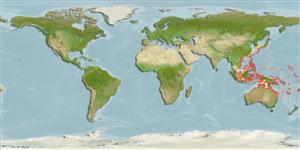Teleostei (teleosts) >
Eupercaria/misc (Various families in series Eupercaria) >
Haemulidae (Grunts) > Plectorhinchinae
Etymology: Plectorhinchus: Greek, plektos = plaited + Greek, rhyngchos = snout (Ref. 45335).
Eponymy: René Primevère Lesson (1794–1849) was a French naturalist and surgeon. [...] (Ref. 128868), visit book page.
More on author: Cuvier.
Environment: milieu / climate zone / depth range / distribution range
Ecology
Marine; reef-associated; depth range 1 - 35 m (Ref. 90102). Tropical
Western Pacific: Malaysia to Melanesia, north to Japan.
Size / Weight / Age
Maturity: Lm ? range ? - ? cm
Max length : 40.0 cm TL male/unsexed; (Ref. 27362)
Inner and outer reef lagoons, usually in caves along steep slopes. Juveniles in shallow lagoons or protected shallow reefs (Ref. 48635). During the day, occurs under coral ledges of channel and outer reef slopes (Ref. 37816). Solitary (Ref. 90102).
Life cycle and mating behavior
Maturity | Reproduction | Spawning | Eggs | Fecundity | Larvae
Oviparous, distinct pairing during breeding (Ref. 205).
Randall, J.E., G.R. Allen and R.C. Steene, 1997. Fishes of the Great Barrier Reef and Coral Sea. Second Edition. Revised and expanded edition. Crawford House Publishing Pty Ltd. Bathurst, NSW, Australia. 557 p. (Ref. 27362)
IUCN Red List Status (Ref. 130435: Version 2024-1)
Threat to humans
Harmless
Human uses
Tools
Special reports
Download XML
Internet sources
Estimates based on models
Preferred temperature (Ref.
123201): 24.9 - 29.3, mean 28.6 °C (based on 1813 cells).
Phylogenetic diversity index (Ref.
82804): PD
50 = 0.5000 [Uniqueness, from 0.5 = low to 2.0 = high].
Bayesian length-weight: a=0.01950 (0.00835 - 0.04555), b=2.95 (2.76 - 3.14), in cm total length, based on LWR estimates for this (Sub)family-body shape (Ref.
93245).
Trophic level (Ref.
69278): 3.7 ±0.6 se; based on size and trophs of closest relatives
Resilience (Ref.
120179): Medium, minimum population doubling time 1.4 - 4.4 years (Preliminary K or Fecundity.).
Fishing Vulnerability (Ref.
59153): Low to moderate vulnerability (30 of 100).
Nutrients (Ref.
124155): Calcium = 35.3 [15.8, 72.7] mg/100g; Iron = 0.538 [0.276, 0.963] mg/100g; Protein = 18.9 [17.0, 20.9] %; Omega3 = 0.101 [0.050, 0.177] g/100g; Selenium = 31.3 [17.5, 56.1] μg/100g; VitaminA = 56.5 [18.0, 173.0] μg/100g; Zinc = 0.976 [0.630, 1.498] mg/100g (wet weight);
